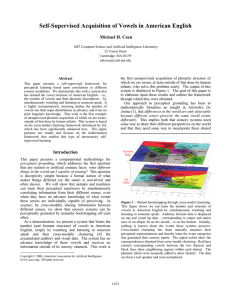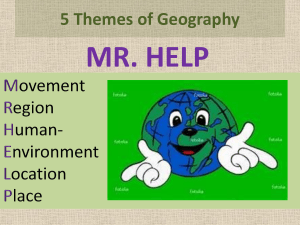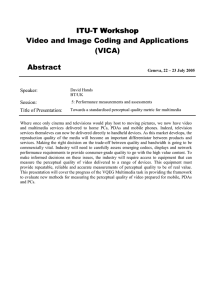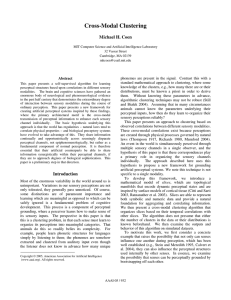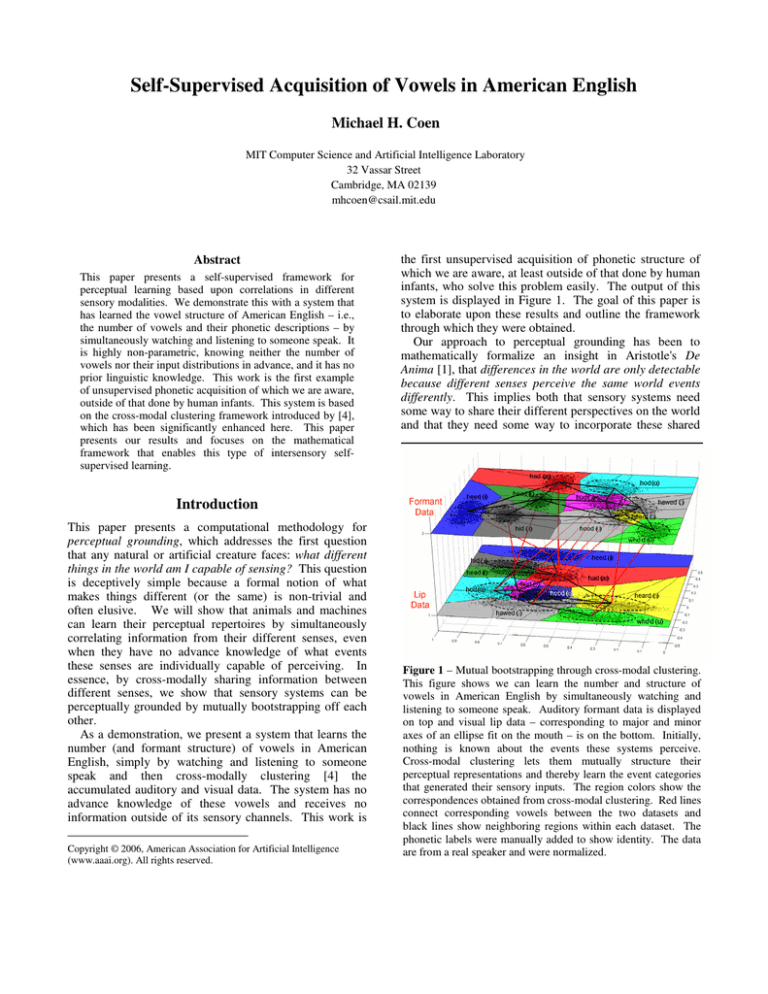
Self-Supervised Acquisition of Vowels in American English
Michael H. Coen
MIT Computer Science and Artificial Intelligence Laboratory
32 Vassar Street
Cambridge, MA 02139
mhcoen@csail.mit.edu
Abstract
This paper presents a self-supervised framework for
perceptual learning based upon correlations in different
sensory modalities. We demonstrate this with a system that
has learned the vowel structure of American English – i.e.,
the number of vowels and their phonetic descriptions – by
simultaneously watching and listening to someone speak. It
is highly non-parametric, knowing neither the number of
vowels nor their input distributions in advance, and it has no
prior linguistic knowledge. This work is the first example
of unsupervised phonetic acquisition of which we are aware,
outside of that done by human infants. This system is based
on the cross-modal clustering framework introduced by [4],
which has been significantly enhanced here. This paper
presents our results and focuses on the mathematical
framework that enables this type of intersensory selfsupervised learning.
the first unsupervised acquisition of phonetic structure of
which we are aware, at least outside of that done by human
infants, who solve this problem easily. The output of this
system is displayed in Figure 1. The goal of this paper is
to elaborate upon these results and outline the framework
through which they were obtained.
Our approach to perceptual grounding has been to
mathematically formalize an insight in Aristotle's De
Anima [1], that differences in the world are only detectable
because different senses perceive the same world events
differently. This implies both that sensory systems need
some way to share their different perspectives on the world
and that they need some way to incorporate these shared
Introduction
This paper presents a computational methodology for
perceptual grounding, which addresses the first question
that any natural or artificial creature faces: what different
things in the world am I capable of sensing? This question
is deceptively simple because a formal notion of what
makes things different (or the same) is non-trivial and
often elusive. We will show that animals and machines
can learn their perceptual repertoires by simultaneously
correlating information from their different senses, even
when they have no advance knowledge of what events
these senses are individually capable of perceiving. In
essence, by cross-modally sharing information between
different senses, we show that sensory systems can be
perceptually grounded by mutually bootstrapping off each
other.
As a demonstration, we present a system that learns the
number (and formant structure) of vowels in American
English, simply by watching and listening to someone
speak and then cross-modally clustering [4] the
accumulated auditory and visual data. The system has no
advance knowledge of these vowels and receives no
information outside of its sensory channels. This work is
Copyright © 2006, American Association for Artificial Intelligence
(www.aaai.org). All rights reserved.
Figure 1 – Mutual bootstrapping through cross-modal clustering.
This figure shows we can learn the number and structure of
vowels in American English by simultaneously watching and
listening to someone speak. Auditory formant data is displayed
on top and visual lip data – corresponding to major and minor
axes of an ellipse fit on the mouth – is on the bottom. Initially,
nothing is known about the events these systems perceive.
Cross-modal clustering lets them mutually structure their
perceptual representations and thereby learn the event categories
that generated their sensory inputs. The region colors show the
correspondences obtained from cross-modal clustering. Red lines
connect corresponding vowels between the two datasets and
black lines show neighboring regions within each dataset. The
phonetic labels were manually added to show identity. The data
are from a real speaker and were normalized.
influences into their own internal workings. This insight
was the basis for the cross-modal clustering framework in
[4], which is the foundation for this work and is
significantly enhanced here. This approach has been
motivated by recent results in the cognitive and
neurosciences [13,2,12] detailing the extraordinary degree
of interaction between modalities during ordinary
perception. These biological motivations are discussed at
length in [3]. We believe that a biologically-inspired
approach can help answer what are historically difficult
computational problems, for example, how to cluster nonparametric data corresponding to an unknown number of
categories. This is an important problem in computer
science, cognitive science, and neuroscience.
We proceed by first defining what is meant by the word
"sense." We then introduce our application domain and
discuss why perceptual grounding is a difficult problem.
Finally, we present our enhancements to cross-modal
clustering and demonstrate how the main results in this
paper were obtained. We note that the figures in this paper
are most easily viewed in color.
What Is a "Sense?"
We have used the word sense, e.g., sense, sensory,
intersensory, etc., without defining what a sense is. One
generally thinks of a sense as the perceptual capability
associated with a distinct, usually external, sensory organ.
It seems quite natural to say vision is through the eyes,
touch is through the skin, etc. However, this coarse
definition of sense is misleading.
Each sensory organ provides an entire class of sensory
capabilities, which we will individually call modes. For
example, we are familiar with the bitterness mode of taste,
which is distinct from other taste modes such as sweetness.
In the visual system, object segmentation is a mode that is
distinct from color perception, which is why we can
appreciate black and white photography.
Most
importantly, individuals may lack particular modes without
other modes in that sense being affected [15], thus
demonstrating they are phenomenologically independent.
Figure 2 – On the left is a spectrogram of the author saying,
“hello.” The demarcated region (from 690-710ms) marks the
onset of phoneme /ao/, corresponding to the start of the vowel "o"
in “hello.” The spectrum corresponding to this 20ms window is
shown on the right. A 12th order linear predictive coding model
is shown overlaid, from which the formants, i.e., the spectral
peaks, are estimated. In this example: F1 = 266Hz, F2 = 922Hz,
and F3 = 2531Hz. Formants above F3 are generally ignored for
sound classification because they tend to be speaker dependent.
Figure 3 – Peterson and Barney Data. A scatterplot of the first
two formants, with different regions labeled by their
corresponding vowel categories.
Therefore, we use a finer grained approach to
perception. From this perspective, intersensory influence
is supported in our model between modes within the same
sensory system, e.g., entirely within vision, or between
modes in different sensory systems, e.g., in vision and
audition. Because the framework presented here is
amodal, i.e., not specific to any sensory system, it treats
both cases equivalently.
Problem Statement
Our demonstration for perceptual grounding has been
inspired by the classic study of Peterson and Barney [10],
who studied recognition of spoken vowels (monophthongs)
in English according to their formant frequencies. (An
explanation of formant frequencies is contained in
Figure 2.) Their observation that formant space could be
approximately partitioned for vowel identification, as in
Figure 3, was among the earliest approaches to spectralbased speech understanding.
The corresponding
classification problem remains a popular application for
machine learning, e.g., [6].
It is well known that acoustically ambiguous sounds
tend to have visually unambiguous features. For example,
visual observation of tongue position and lip contours can
help disambiguate unvoiced velar consonants /p/ and /k/,
voiced consonants /b/ and /d/, and nasals /m/ and /n/, all of
which can be difficult to distinguish on the basis of
acoustic data alone. Articulation data can also help to
disambiguate vowels, as shown in Figure 4. The images
are taken from a mouth tracking system written by the
author, where the mouth position is modeled by the major
and minor axes of an ellipse fit onto the speaker's lips.
In Figure 5A, we examine formant and lip data side-byside, in color-coded, labeled scatterplots over the same set
of 10 vowels in American English. We note that
ambiguous regions in one mode tend to be unambiguous in
the other and vice versa. It is easy to see how this type of
intersensory disambiguation could enhance speech
recognition, which is a well-studied computational
problem [11].
Perhaps most importantly, perceptual grounding is
difficult because there is no objective mathematical
definition of "coherence" or "similarity."
In many
approaches to clustering, each cluster is represented by a
prototype that, according to some well-defined measure, is
an exemplar for all other data it represents. However, in
the absence of fairly strong assumptions about the data
being clustered, there may be no obvious way to select this
measure. In other words, it is not clear how to formally
define what it means for data to be objectively similar or
dissimilar.
Figure 4 – Modeling lip contours with ellipses. The scatterplot
shows normalized major (x) and minor (y) axes for ellipses
corresponding to the same vowels as those in Figure 3. In this
space, a closed mouth corresponds to a point labeled null. Other
lip contours can be viewed as offsets from the null configuration
and are shown here segmented by color. These data points were
collected from video of this woman speaking.
Nature Does Not Label Its Data
We are interested here, however, in a more fundamental
problem: how do sensory systems learn to segment their
inputs to begin with? In the color-coded plots in Figure
5A, it is easy to see the different represented categories.
However, perceptual events in the world are generally not
accompanied with explicit category labels.
Instead,
animals are faced with data like those in Figure 5B and
must somehow learn to make sense of them. We want to
know how the categories are learned in the first place. We
note this learning process is not confined to development,
as perceptual correspondences are plastic and can change
over time.
We would therefore like to have a general purpose way
of taking data (such as shown in Figure 5B) and deriving
the kinds of correspondences and segmentations (as shown
in Figure 5A) without external supervision. This is what
we mean by perceptual grounding and our perspective here
is that it is a clustering problem: animals must learn to
organize their perceptions into meaningful categories.
Why is this difficult?
As we have noted above, Nature does not label its data. By
this, we mean that the perceptual inputs animals receive are
not generally accompanied by any meta-level data
explaining what they represent. Our framework must
therefore assume the learning is unsupervised, in that there
are no data outside of the perceptual inputs themselves
available to the learner.
From a clustering perspective, perceptual data is highly
non-parametric in that both the number of clusters and
their underlying distributions are unknown. Clustering
algorithms generally make strong assumptions about one
or both of these and when faced with nonparametric,
distribution-free data, algorithmic clustering techniques
tend not be robust [7,14].
The Simplest Complex Example
We proceed by means of an example. Let us consider two
hypothetical sensory modes, each of which is capable of
sensing the same two events in the world, which we call
the red and blue events. These two modes are illustrated in
Figure 6, where the dots within each mode represent its
perceptual inputs and the blue and red ellipses delineate the
two events. For example, if a "red" event takes place in the
world, each mode would receive sensory input that
(probabilistically) falls within its red ellipse. Notice that
events within each mode overlap, and they are in fact
represented by a mixture of two overlapping Gaussian
distributions. We have chosen this example because it is
Figure 5A (top): Labeled scatterplots side-by-side. Formant
data is displayed on the left and lip contour data is on the right.
Each plot contains data corresponding to the ten listed vowels in
American English
Figure 5B (bottom): Unlabeled data. These are the same data
shown in Figure 5A, with the labels removed. This picture is
closer to what animals actually encounter in Nature. As above,
formants are displayed on the left and lip contours are on the
right. Our goal is to learn the categories present in these data
without supervision, so that we can automatically derive the
categories and clusters such as those shown directly above.
Mode A
Mode B
1
1
0.9
0.9
0.8
0.8
0.7
0.7
0.6
0.6
0.5
0.5
0.4
0.4
0.3
0.3
0.2
0.2
0.1
0
-0.5
0.1
-0.4
-0.3
-0.2
-0.1
0
0.1
0.2
0.3
0.4
0.5
0
-0.5
-0.4
-0.3
-0.2
-0.1
0
0.1
0.2
0.3
0.4
0.5
Figure 6 – Two hypothetical co-occurring perceptual modes.
Each mode, unbeknownst to itself, receives inputs generated by a
simple, overlapping Gaussian mixture model. To make matters
more concrete, we might imagine Mode A is a simple auditory
system that hears two different events in the world and Mode B is
a simple visual system sees those same two events, which are
indicated by the red and blue ellipses.
simple – each mode perceives only two events – but it has
the added complexity that the events overlap – meaning
there is likely to be some ambiguity in interpreting the
perceptual inputs.
Keep in mind that while we know there are only two
events (red and blue) in this hypothetical world, the modes
themselves do not "know" anything at all about what they
can perceive. The colorful ellipses are solely for the
reader's benefit; the only thing the modes receive is their
raw input data. Our goal then is to learn the perceptual
categories in each mode – e.g., to learn that each mode in
this example senses these two overlapping events – by
exploiting the spatiotemporal correlations between them.
Defining Slices
Our approach is to represent the modes' perceptual inputs
within slices [4,5]. Slices are a convenient way to
discretely model perceptual inputs (see Figure 7) and are
inspired by surface models of cortical tissue. Formally,
they are topological manifolds that discretize data within
Voronoi partitionings, where the regions' densities have
been normalized.
Intuitively, a slice is a codebook [8] with a nonEuclidean distance metric defined between its cluster
centroids. In other words, distances within each cluster are
Euclidean, whereas distances between clusters are not. A
topological manifold is simply a manifold "glued" together
from Euclidean spaces, and that is exactly what a slice is.
Figure 7 – Slices generated for Modes A and B using the
hyperclustering algorithm in [5]. We refer to each Voronoi
cluster within a slice as a codebook region.
Figure 8 – Combining codebook regions within a slice to
construct perceptual regions. We would like to determine that
regions within each ellipse are all part of the same perceptual
event. Here, for example, the two blue codebook regions
(probabilistically) correspond to the blue event and the red
regions correspond to the red event.
We will refer to each individual cluster within a slice as a
codebook region, and will define the non-Euclidean
distance metric between them below.
Our approach
We would like to assemble the clusters within each slice
into larger regions that represent actual perceptual
categories present in the input data. Consider the colored
regions in Figure 8. We would like to determine that the
blue and red regions are part of their respective blue and
red events, indicated by the colored ellipses. We proceed
by formulating a metric that minimizes the distance
between codebook regions that are actually within the
same perceptual region and maximizes the distance
between codebook regions that are in different regions.
That this metric must be non-Euclidean is clear from
looking at the figure. Each highlighted region is closer to
one of a different color than it is to its matching partner.
Towards defining this metric, we first collect cooccurrence data between the codebook regions in different
modes. We want to know how each codebook region in a
mode temporally co-occurs with the codebook regions in
other modes. This data can be easily gathered with the
classical sense of Hebbian learning, where connections
between regions are strengthened as they are
simultaneously active. The result of this process is
illustrated in Figure 9, where the slices are vertically
stacked to make the correspondences clearer. We will
exploit the spatial structure of this Hebbian co-occurrence
data to define the distance metric within each mode.
Hebbian Projections
We define the notion of a Hebbian projection. These are
spatial probability distributions that provide an intuitive
way to view co-occurrence relations between different
slices. We first give a formal definition and then illustrate
the concept visually.
Consider two slices M A , M B ⊆ n , with associated
codebooks C A = { p1 , p2 ,..., pa } and CB = {q1 , q2 ,..., qb } , with
cluster centroids pi , q j ∈ N . We define the Hebbian
projection of a pi ∈ C A onto mode M B :
1
0.53
0.9
0.52
0.8
0.7
0.51
0.6
0.5
0.5
0.4
0.49
0.3
0.2
0.48
0.1
0.47
0
0
Figure 9 – Viewing Hebbian linkages between two different
slices. The slices have been vertically stacked here to make the
correspondences clearer. The blue lines indicate that two
codebook regions temporally co-occur with each other. Note that
these connections are weighted based on their strengths, which
are not visually represented here, and that these weights are
additionally asymmetric between each pair of connected regions.
0.1
0.2
0.3
0.4
0.5
0.6
0.7
0.8
0.9
1
0.47
0.48
0.49
0.5
0.51
0.52
0.53
Figure 11 – Intuitively defining similarity. We consider the two
distributions illustrated in Example A to be far more similar to
one another than those in Example B, even though many metrics
would deem them further apart due to inherent Euclidean biases.
Notice that the distributions in Example A cover roughly two
orders of magnitude more area than those in Example B.
Similarity distance [5] measures the overlap in spatial density
between two distributions and is thereby scale invariant.
H AB ( pi ) = [ Pr(q1 | pi ), Pr(q2 | pi ),...,Pr(qb | pi )]
A Hebbian projection is simply a conditional spatial
probability distribution that lets us know what mode M B
probabilistically "looks" like when a region pi is active in
co-occurring mode M A . This is visualized in Figure 10.
We can equivalently define a Hebbian projection for a
region r ⊆ M A constructed out of a subset of its codebook
clusters Cr = { pr1 , pr 2 ,..., prk } ⊆ C A :
H AB (r ) = [ Pr(q1 | r ),Pr(q2 | r ),..., Pr(qb | r )]
A Cross-Modal Distance Metric
We use the Hebbian projections defined in the previous
section to define the distance between codebook regions.
This will make the metric inherently cross-modal, because
we will rely on co-occurring modalities to determine how
similar two regions within a slice are. Our approach is to
determine the distance between codebook regions by
comparing their Hebbian projections onto co-occurring
slices. This process is illustrated in Figure 12.
The problem of measuring distances between prototypes
is thereby transformed into a problem of measuring
Mode
B
Mode
A
Figure 10 – Visualizations of Hebbian projections. On the left,
we project from a cluster pi in Mode A onto Mode B. The dotted
lines correspond to Hebbian linkages and the blue shading in
each cluster qj in Mode B is proportional to Pr(qj|pi). A Hebbian
projection lets us know what Mode B probabilistically "looks"
like when some prototype in Mode A is active. On the right, we
see a projection from a cluster in Mode B onto Mode A.
similarity between spatial probability distributions. The
distributions are spatial because the codebook regions have
definite locations within a slice, which are subspaces of
n . Hebbian projections are thus spatial distributions on
n-dimensional data. It is therefore not possible to use one
dimensional metrics, e.g., Kolmogorov-Smirnov distance,
to compare them because doing so would throw away the
essential spatial information within each slice. Instead, we
use the notion of Similarity distance defined in [5], which
measures the density overlap between distributions on a
metric space. This notion is intuitively illustrated in Figure
11. For the results below, we replace the cross-modal
distance metric in [4] with Similarity distance and use the
same cross-modal clustering algorithm. Additional details
are contained in [5].
Experimental Results
To learn the vowel structure of American English, data was
gathered according to the same pronunciation protocol
employed by [10]. Each vowel was spoken within the
context of an English word beginning with [h] and ending
with [d]; for example, /ae/ was pronounced in the context
of "had." Each vowel was spoken by an adult female
approximately 90-140 times. The speaker was videotaped
and we note that during the recording session, a small
number of extraneous comments were included and
analyzed with the data. The auditory and video streams
were then extracted and processed.
Formant analysis was done with the Praat system, using
a 30ms FFT window and a 12th order linear predictive
coding model. Lip contours were extracted using the
system described above. Time-stamped formant and lip
contour data were fed into slices in an implementation of
the work in [4], using the Similarity distance described
above. We note this implementation was used to generate
most of the figures in this paper, which represent actual
system outputs. The identifying phonetic labels were
manually added to the figures for reference.
heed (i)
r2
hid (ɪ)
head (ε)
had (æ)
Formant F2
r1
hud (ʌ)
hod (α)
hood (ʊ)
who’d (u)
heard (ɜ)
hawed (ɔ)
Formant F1
Figure 13 – Self-supervised acquisition of vowels
(monophthongs) in American English. The identifying labels
were manually added for reference and ellipses were fit onto the
regions to aid visualization. Unlabeled regions here have
ambiguous classifications. All data have been normalized. Note
the correspondence between this and the Peterson-Barney data
shown in Figure 3.
Pr(Mode A|r1 )
Pr(Mode A|r2 )
How similar are
Pr(Mode A|r1 ) and Pr(Mode A|r2 ) ?
Figure 12 – Our approach to computing distances cross-modally.
To determine the distance between codebook regions r1 and r2 in
Mode B on top, we project them onto a co-occurring modality
Mode A as shown in the middle, by examining their conditional
probability distributions. We then ask how similar these
projections onto Mode A are, as shown on the bottom. We have
thereby transformed our question about distance between regions
into a question of similarity between their conditional spatial
probability distributions in a co-occurring modality. This is
computed via their Similarity distance.
The results of this experiment are shown in Figures 1
and 13. This is the first unsupervised acquisition of human
phonetic data of which we are aware. The work of de Sa
[6] has studied unsupervised cross-modal refinement of
perceptual boundaries, but it requires that the number of
categories (e.g., the number of vowels) be known in
advance. We note also there is a vast literature on
unsupervised clustering techniques, but these generally
make strong assumptions about the data being clustering or
they have no corresponding notion of correctness
associated with their results. The intersensory approach
taken here is entirely non-parametric and makes no a priori
assumptions about underlying distributions or the number
of clusters being represented.
Acknowledgements
The author is indebted to Whitman Richards, Howard
Shrobe, Patrick Winston, and Robert Berwick for
encouragement and feedback. This work is sponsored by
AFRL under contract #FA8750-05-2-0274. Thanks to the
DARPA/IPTO BICA program and to AFRL. The author
also thanks the anonymous reviewers for their insightful
comments.
References
1. Aristotle. De Anima. 350 BCE. Translated by Tancred, H.L.
Penguin Classics. London. 1987.
2. Calvert, A.G., Spence, C., and Stein, B.E. The Handbook of
Multisensory Processes. Bradford Books. 2004.
3. Coen, M.H. Multimodal interaction: a biological view. In Proceedings
of 17th International Joint Conference on Artificial Intelligence.
(IJCAI-01). Seattle, Washington. 2001.
4. Coen, M.H. Cross-Modal Clustering. In Proceedings of the Twentieth
National Conference on Artificial Intelligence (AAAI'05), pp. 932937. Pittsburg, PA. 2005.
5. Coen, M. H. Multimodal Dynamics: Self-Supervised Learning in
Perceptual and Motor Systems. Ph.D. Thesis. Massachusetts Institute
of Technology. 2006.
6. de Sa, V.R. Unsupervised Classification Learning from Cross-Modal
Environmental Structure. Doctoral Dissertation, Department of
Computer Science, University of Rochester. 1994.
7. Fraley, C. and Raftery, A.E. (2002). Model-Based Clustering,
Discriminant Analysis, and Density Estimation. Journal of the
American Statistical Association, 97, 611-631.
8. Gray, R.M. Vector Quantization. IEEE ASSP, pp. 4--29, April 1984.
9. Kantorovich L., On the translocation of masses, C. R. Acad. Sci.
URSS (N.S) 37:199-201. 1942. (Republished in Journal of
Mathematical Sciences, Vol. 133, No. 4, 2006. Translated by A.N.
Sobolevskii.)
10.Peterson, G.E. and Barney, H.L. Control methods used in a study of
the vowels. J.Acoust.Soc.Am. 24, 175-184. 1952.
11.Potamianos, G., Neti, C., Luettin, J., and Matthews, I. Audio-Visual
Automatic Speech Recognition: An Overview. In: Issues in Visual
and Audio-Visual Speech Processing, G. Bailly, E. VatikiotisBateson, and P. Perrier (Eds.), MIT Press. 2004.
12.Spence, C., & Driver, J. (Eds.) . Crossmodal space and crossmodal
attention. Oxford, UK: Oxford University Press. 2004.
13.Stein, B.E., and Meredith, M. A. The Merging of the Senses.
Cambridge, MA. MIT Press. 1994.
14.Still, S., and Bialek, W. How many clusters? An information theoretic
perspective, Neural Computation. 16:2483-2506. 2004.
15.Wolfe, J.M. Hidden visual processes. Scientific American, 248(2), 94103. 1983.

